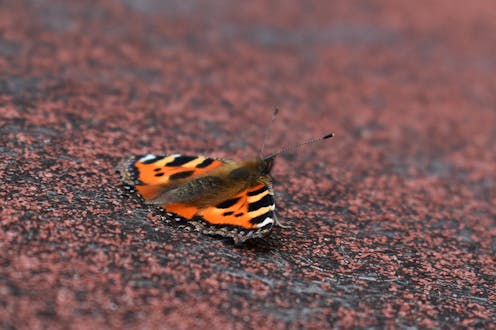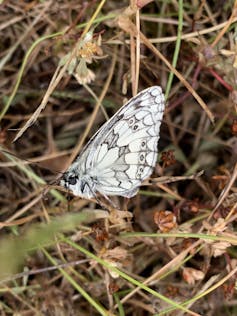
The Butterfly Conservation charity’s big butterfly count asks the UK public to record butterflies wherever they see them each summer. In 2024 so far, sightings are the lowest in the survey’s 14-year history.
Cool weather in Britain this summer is partially to blame. The butterflies are still somewhere though. On a cool day, they’re nowhere to be seen but when it’s hot, they suddenly reappear, so where do they go?
Like all insects, butterflies are poikilotherms – they don’t produce their own body heat like humans do. Instead, they rely on the ambient temperature for everything their body does: moving, growing and their general metabolism.
When it’s cold, a butterfly’s metabolic rate slows down and the demands on its body diminish, allowing them to stay dormant for a while. Lots of species are adapted to do this – the warm days rouse them and allow them to be active again.
Some of the first butterflies you see in early spring are species that overwinter in Britain as adults. Species such as the lime-coloured brimstone effectively freeze, pausing their lives in accordance with the cold winter. Small tortoiseshell and peacock butterflies also do this and hide anywhere dry and sheltered. This should ideally be woodland or hedges, but they’re also common in sheds and I even found one in a bedroom cupboard once. When it’s rainy, lots of species hide away in those same places, or in the long grass.

Wasting time
It may sound like butterflies are all set to go once the weather brightens and can wait out the cold in the meantime. This is only true up to a point. The problem this year is the long rainy spells and harsh winds have made it difficult for them to find food or mates.
Do the seasons feel increasingly weird to you? You’re not alone. Climate change is distorting nature’s calendar, causing plants to flower early and animals to emerge at the wrong time.
This article is part of a series, Wild Seasons, on how the seasons are changing – and what they may eventually look like.
Butterflies can tolerate a wide range of temperatures. More tolerant species are able to thrive in lots of different habitats and conditions (what scientists call generalists) and are typically more mobile. However, specialist butterflies with tighter temperature ranges and more specific habitat preferences are more vulnerable, restricted to areas that are more reliably warm and dry like the Adonis blue, which lives in chalk grasslands, or reliably cool, like the high-altitude mountain ringlet.
Some species are built for cool, cloudy days, as you would expect from a British butterfly. A good example is the large white, whose bright wings reflect sunlight. If this species wants to warm up it can direct the sunlight towards its body by changing the angle of its wings.

Such adaptations mean that butterfly numbers can shift suddenly. If more favourable weather appears and they’re suitably adapted to wait it out, they’ll emerge later in the year. However, they can only stay still for so long.
Most butterflies have relatively short lifespans and must time their foraging when flowers are abundant (so they have a source of nectar) and there are plenty of leaves on particular plants to lay eggs on. They need to make the most out of every day. The longer the delays caused by unfavourable weather, the higher the risk of dying with no offspring.
If their activities are delayed every now and then by a rainy day (or a hot one for alpine butterflies in particular) – that’s fine, this is Britain, and any species adapted to living here is well prepared.
The issue this year is persistent, consecutive days of poor weather. Time wasted hiding is less time pollinating and finding mates. Surveying woodland butterflies in Milton Keynes in southern England, I have seen a few species like ringlet and meadow brown braving cloudy days fairly often, even sometimes foraging in drizzle. But any more rain than that, plus wind, sees them all sheltering until it’s over.
2024 in context
This summer has been quite bad for butterflies, but it’s still too early to tell how bad. A good spring – warm and sunny with a gentle breeze – can boost species which have a summer brood later in the year, and vice versa. However, this year’s cool and wet spring wasn’t ideal either.
The summer of 2022 was very poor for butterflies for the opposite reason: July’s heatwave caused many of the plants butterflies rely on to wilt.
Butterfly populations bounced back in 2023 with a delightful flurry of red admirals, but overall butterfly numbers will probably fall again.

This is part of an alarming downward trend for biodiversity. In the 1970s, there was a long and widespread drought for several months. Many populations did not recover fully, or recovered very slowly, as climate change and habitat loss tightened their grip over subsequent decades.
There is little habitat left for butterflies and their associated plants. Some species are adapted to living in what remains, but barriers like roads, pesticides and other pollutants, less space and more unpredictable weather caused by climate change heap on pressure.
Butterfly havens
People creating habitat in their gardens for butterflies are often encouraged to choose a “sunny but sheltered” spot. That’s what a good summer for butterflies looks like: sun, some rain and a little wind.

Britain once had large, broadleaved woodlands interspersed with meadows, grazed by wild animals like bison. These are the conditions our native wildlife is adapted for.
My recent study showed that wooded areas in towns and cities with a mixture of shade, sunny spots, shrubs, tall trees and open grassland provide the most suitable habitat for butterflies and can squeeze the most out of remaining wild areas. The same can be said for road verges.
Remember: “neat and tidy” usually means “anti-butterfly”.
Willow Neal receives funding from Central England NERC Training Alliance (CENTA).
This article was originally published on The Conversation. Read the original article.







